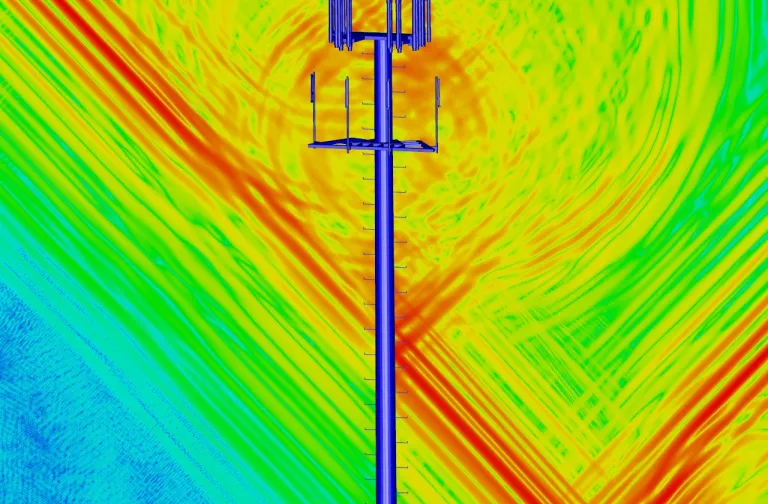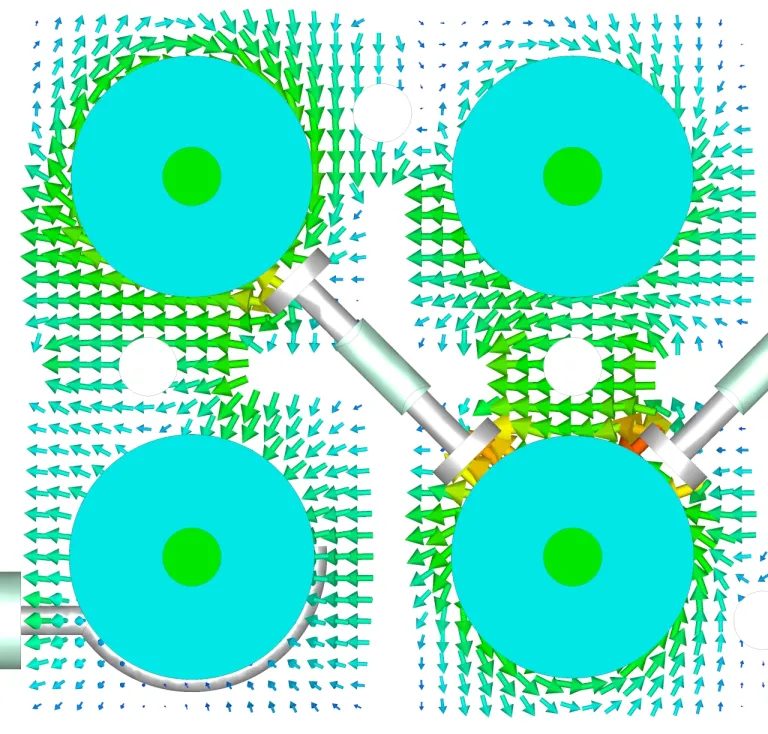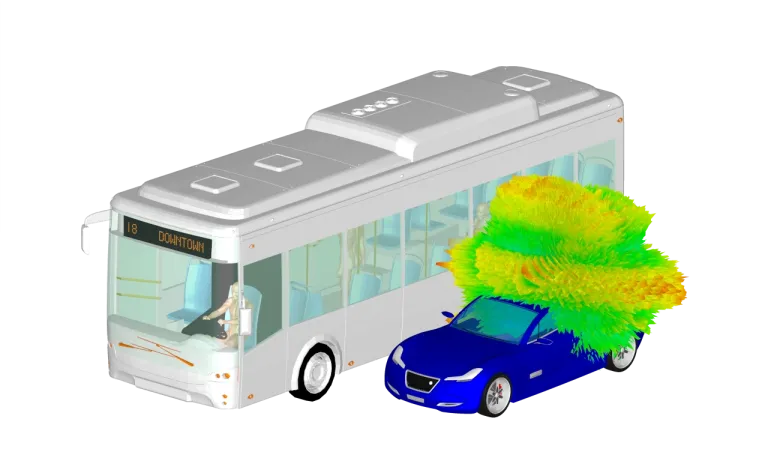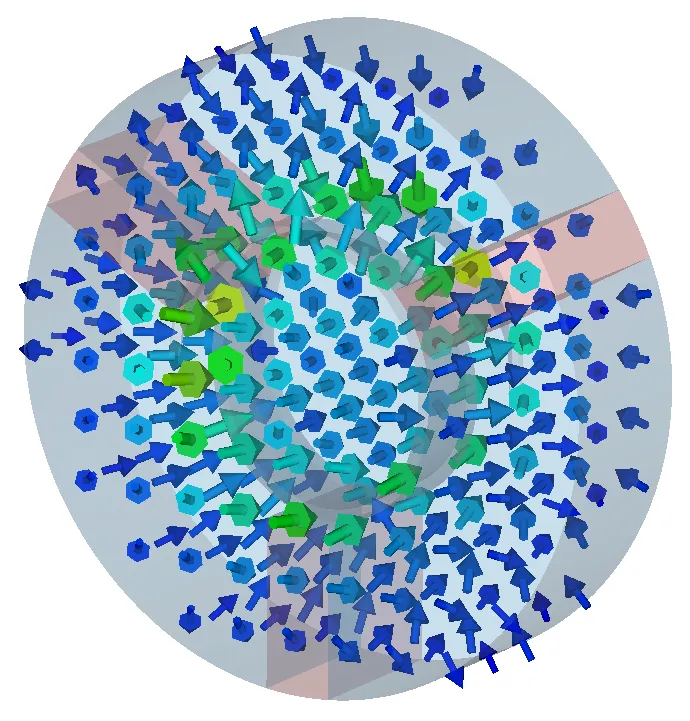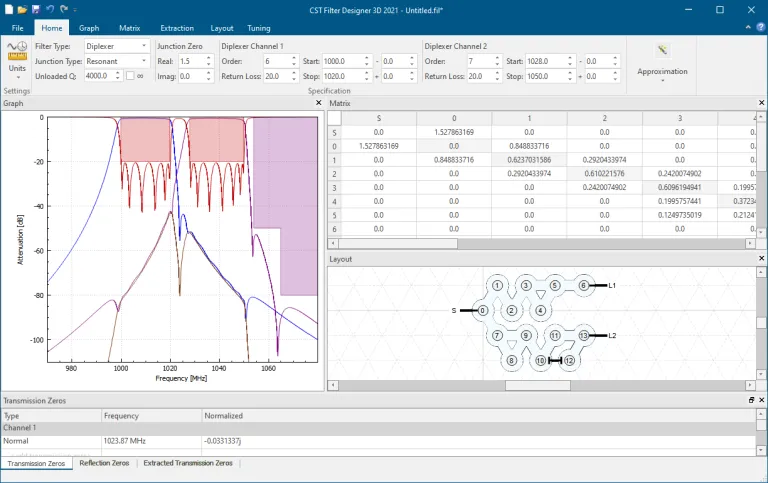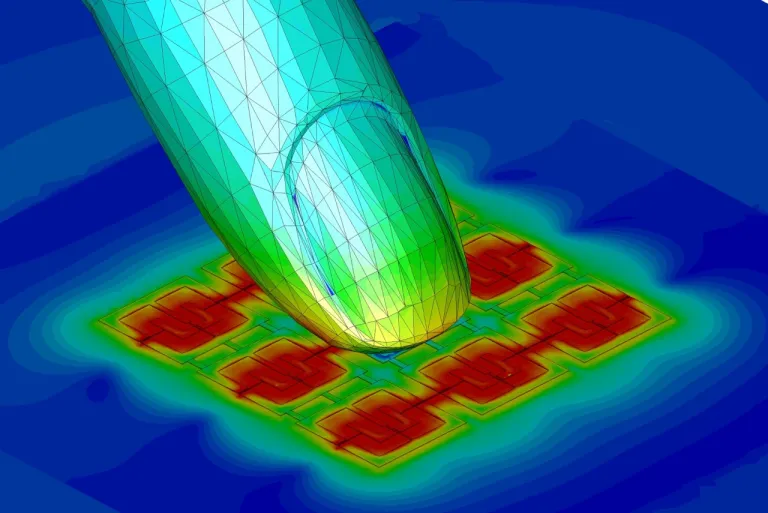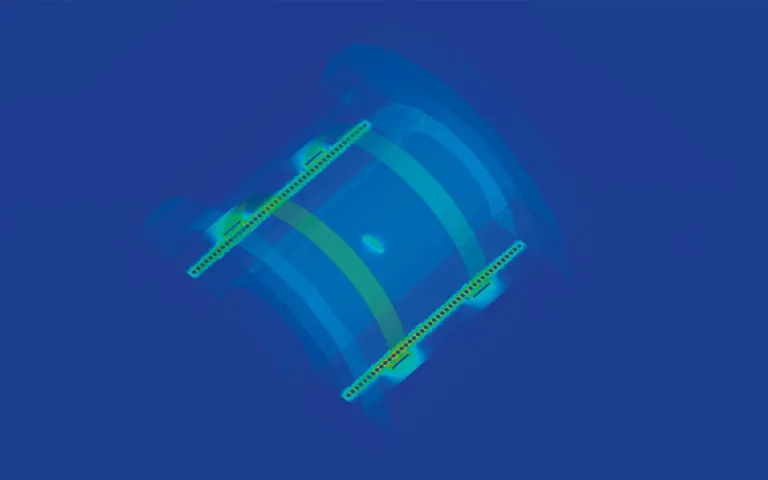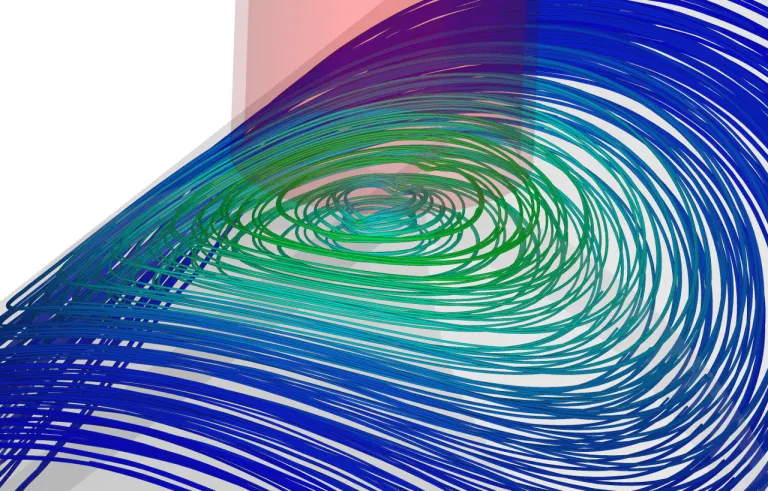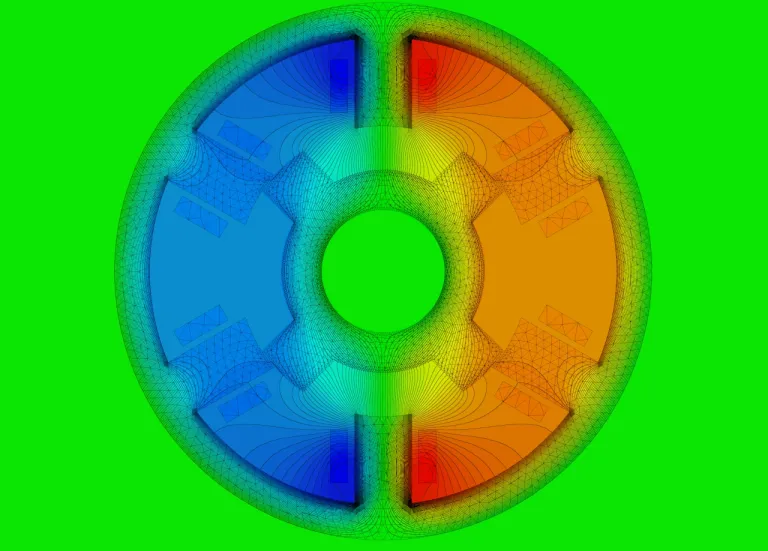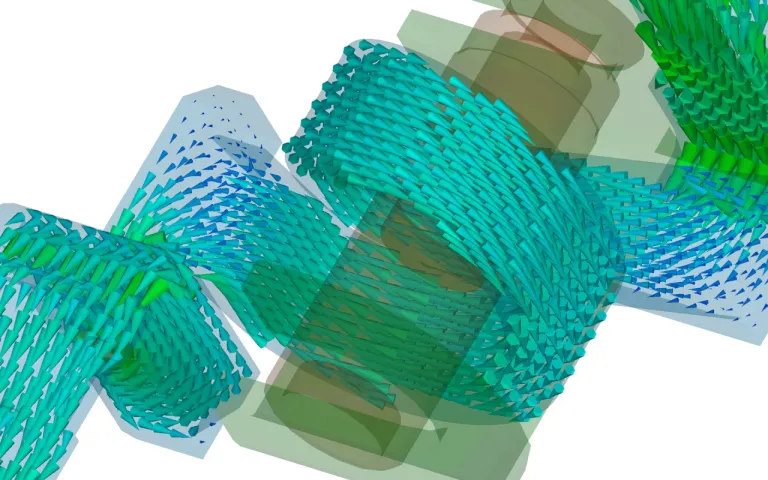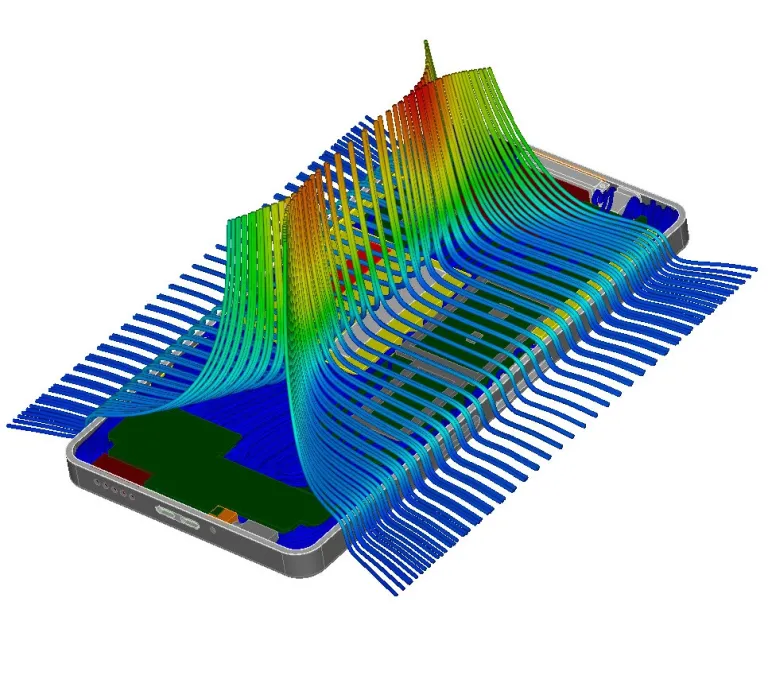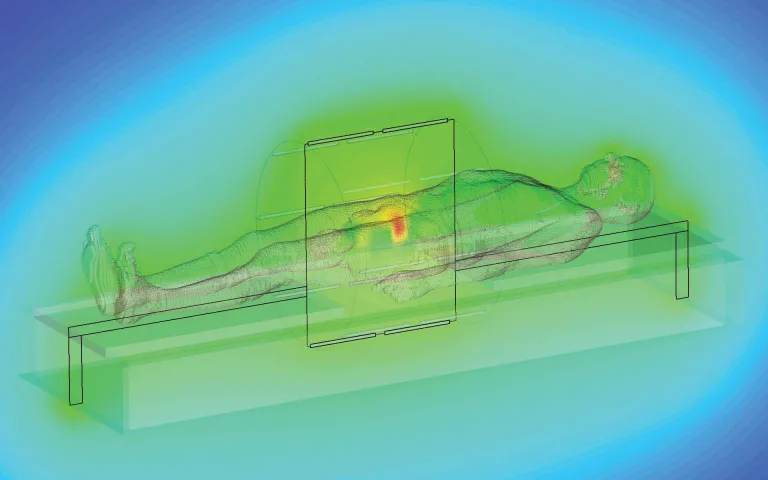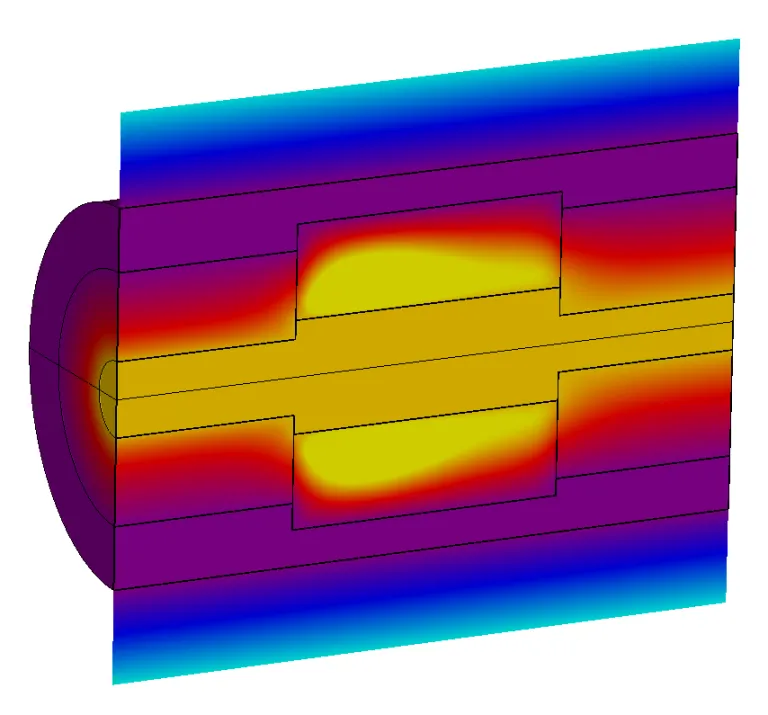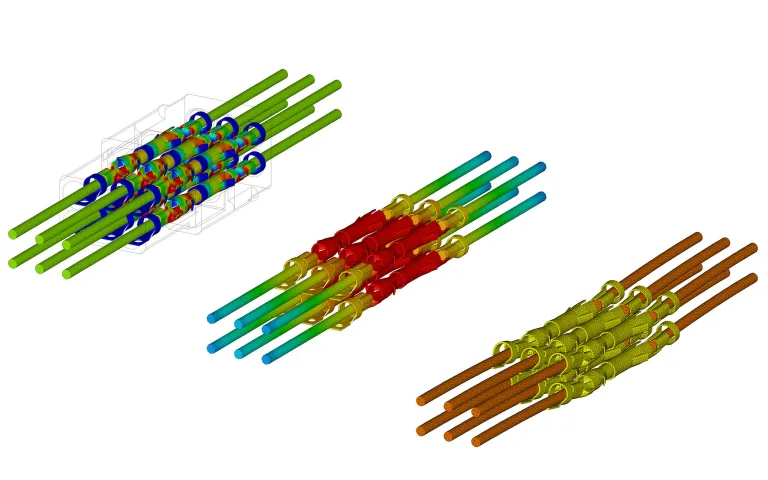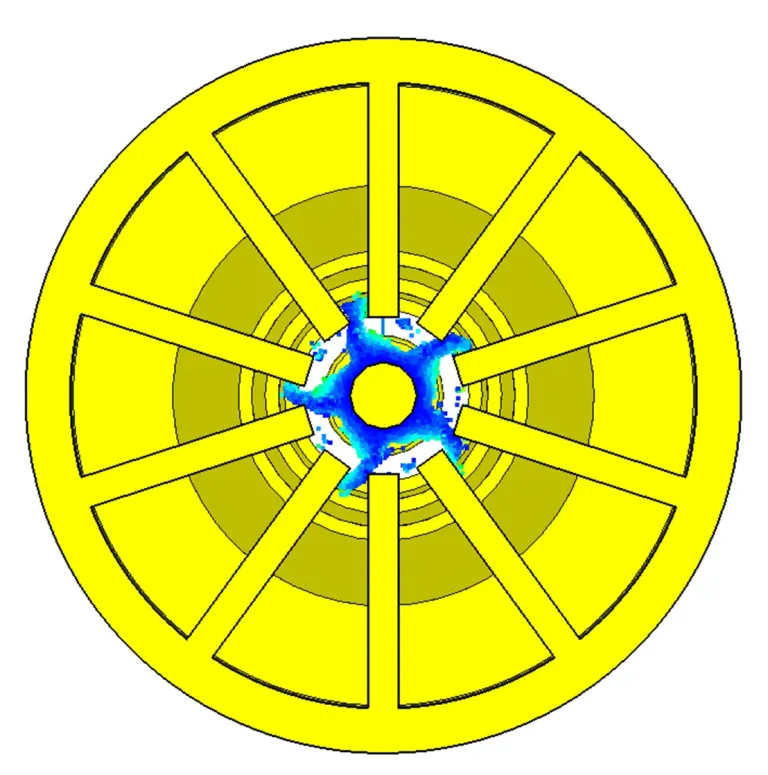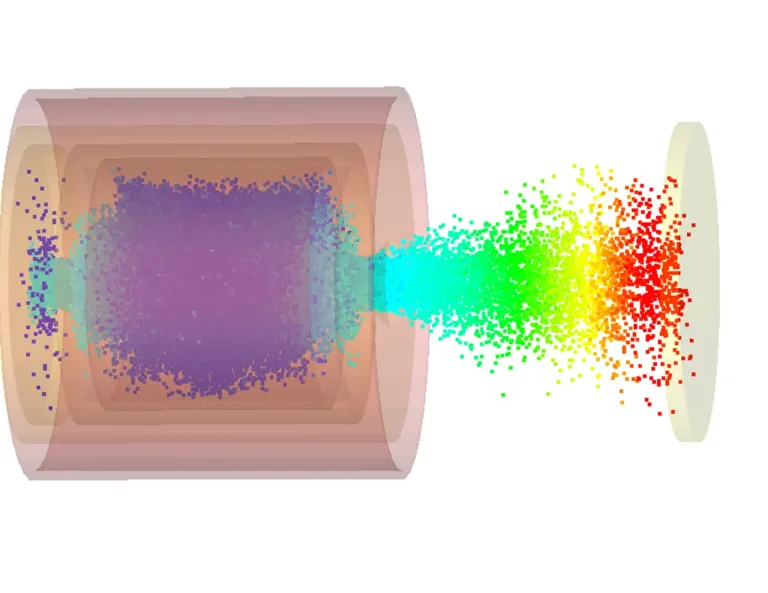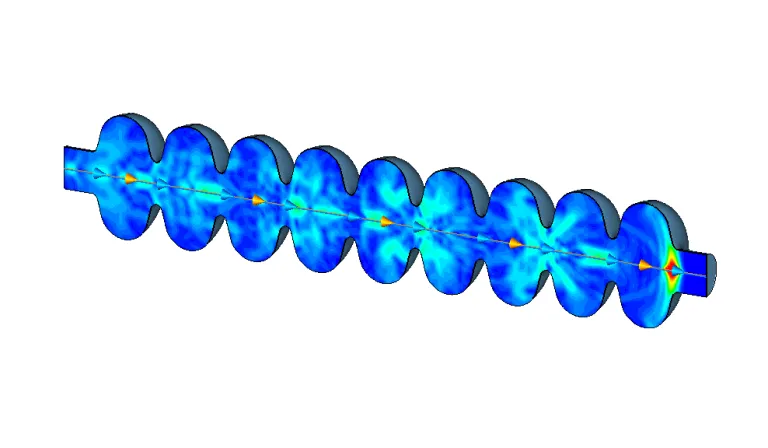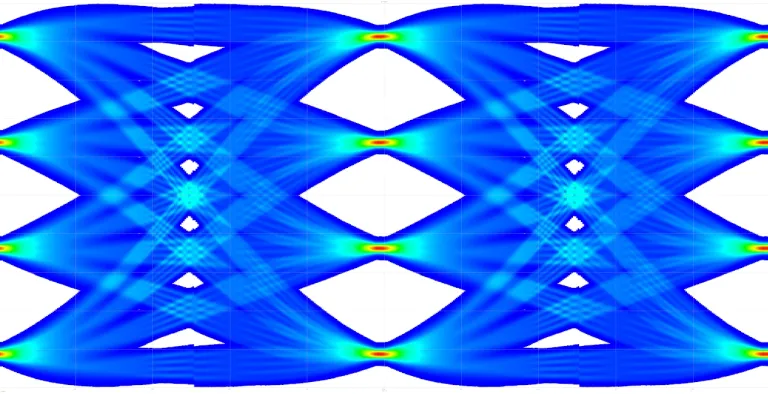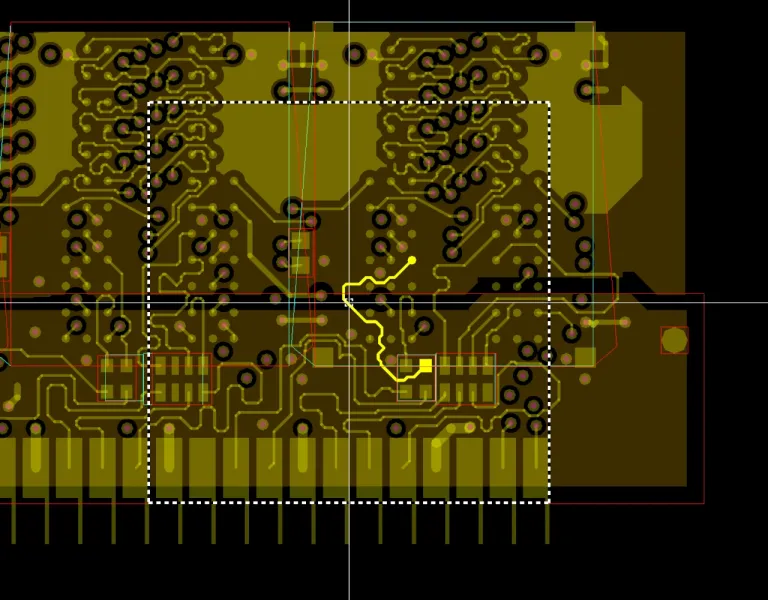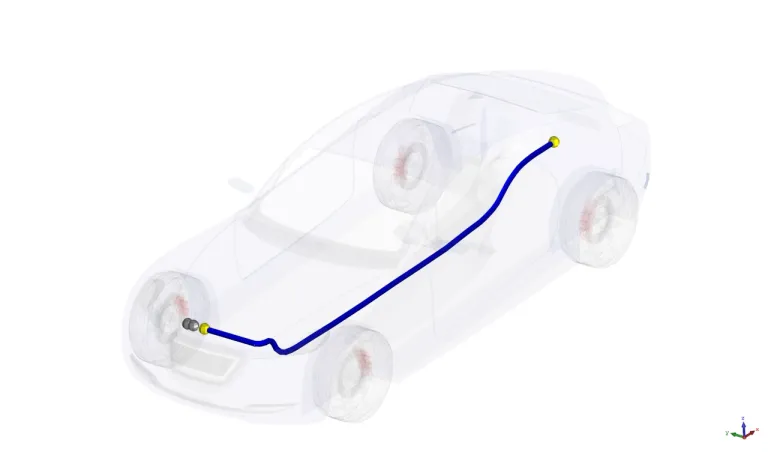Electromagnetic Simulation Solvers
CST Studio Suite Simulation Solvers for Electromagnetic Systems and Devices
A Powerful Portfolio of Electromagnetic Field Solvers
CST Studio Suite® gives customers access to multiple electromagnetic (EM) simulation solvers. The range includes methods such as the finite element method (FEM) the finite integration technique (FIT), and the transmission line matrix method (TLM). The named three methods represent the most powerful general-purpose solvers for electromagnetic simulation tasks. CST Studio Suite offers solution methods in time domain and in frequency domain. The applicability range of the CST Studio Suite solution spans from statics to optical frequencies.
Electromagnetic Solvers by Frequency Range and Application
High-Frequency Electromagnetic Simulation Solvers
With the FIT, FEM and TLM methods CST Studio Suite provides solvers that are ideally suited for high-frequency simulations. FIT and TLM as classical time domain methods can play their advantages for broadband, antenna, and complex and detail-rich applications. These solvers can also analyze the electromagnetic compatibility (EMC) of devices and signal and power integrity. Additional solvers for specialist high-frequency applications such as electrically large or highly resonant structures complement the general-purpose solvers.
Low-Frequency Electromagnetic Simulation Solvers
CST Studio Suite includes FEM solvers dedicated to static and low-frequency applications such as electromechanical devices, motors, generators, transformers, and sensors. Opera technology complements this solver set for a comprehensive and highly accurate solution.
Solvers for Charged Particle Dynamics
The simulation of particles in electromagnetic fields is a particular strength of CST Studio Suite. There is a wide range of applications, from electron guns to microwave tubes, from magnetron sputtering to particle accelerator components. We can deliver suitable solvers for the efficient simulation of particle-based devices.
Multiphysics with CST Studio Suite
The presence of electromagnetic fields causes effects from other physics. The losses in materials lead to increases in temperature. The increased temperature can cause deformations to the components that compromise their performance. CST Studio Suite offers multiphysics simulation to analyze these effects. The range of applications includes electronics cooling as well as bio-heat consideration for medical devices. The 3DEXPERIENCE platform enables a far wider range of multiphysics applications.
Electromagnetic Analysis with the Best Solver for Your Application
The seamless integration of the solvers into one user interface in CST Studio Suite enables the easy selection of the most appropriate simulation method for a given problem class. Being able to choose between simulation approaches leads to improved simulation performance and unprecedented simulation reliability through cross-verification.
- High Frequency Solvers
- Low Frequency Solvers
- Multiphysics Solvers
- Particle Solvers
- EMC and EDA Solvers
Time Domain Solver
The Time Domain Solver is a powerful and versatile multi-purpose transient 3D full-wave solver, with both finite integration technique (FIT) and transmission line matrix (TLM) implementations included in a single package. The Time Domain Solver can perform broadband simulations in a single run. Support for hardware acceleration and MPI cluster computing also makes the solver suitable for extremely large, complex and detail-rich simulations.
Applications of the Time Domain Solver:
- General high-frequency applications using medium-to-large models
- Transient effects
- 3D electronics
Frequency Domain Solver
The Frequency Domain Solver is a powerful multi-purpose 3D full-wave solver, based on the finite element method (FEM), that offers excellent simulation performance for many types of component. Because the Frequency Domain Solver can calculate all ports at the same time, it is also a very efficient way to simulate multi-port systems such as connectors and arrays. The Frequency Domain Solver includes a model-order reduction (MOR) feature which can accelerate the simulation of resonant structures such as filters.
Applications of the Frequency Domain Solver:
- General high-frequency applications using small-to-medium-sized models
- Resonant structures
- Multi-port systems
- 3D electronics
Asymptotic Solver
The Asymptotic Solver is a ray tracing solver which is efficient for extremely large structures where a full-wave solver is unnecessary. The Asymptotic Solver is based on the Shooting Bouncing Ray (SBR) method. SBR is an extension to physical optics, and capable of tackling simulations with an electric size of many thousands of wavelengths.
Applications of the Asymptotic Solver:
- Electrically very large structures
- Installed performance of antennas
- Scattering analysis
Eigenmode Solver
The Eigenmode Solver is a 3D solver for simulating resonant structures, incorporating the Advanced Krylov Subspace method (AKS), and the Jacobi-Davidson method (JDM). Common applications of the Eigenmode Solver are highly resonant filter structures, high-Q particle accelerator cavities, and slow wave structures such as traveling wave tubes. The Eigenmode Solver supports sensitivity analysis, allowing the direct calculation of the detuning effect of structural deformation.
Applications of the Eigenmode Solver:
- Filters
- Cavities
- Metamaterials and periodic structures
Filter Designer 3D
A synthesis tool for designing bandpass and diplexer filters, producing a range of coupling matrix topologies for the application in arbitrary coupled-resonator based technology. It also offers a choice of building blocks to realize 3D filters through Assembly Modeling. From the Component Library, the user can choose between combline/interdigital coaxial cavities and rectangular waveguides. Alternatively, the user can define customized building blocks of any type of single-mode technology (for example SIW or dielectric pucks).
The functionality provided includes the coupling matrix extraction. It can directly be used as a goal for optimization of a simulation model or for assistance in tuning complex hardware by real-time measurements using a network analyzer.
Applications of Filter Designer3D:
- Cross-coupled filters for different electromagnetic technologies (for example cavities, microstrips, dielectrics)
- Assistive tuning for filter hardware (with vector network analyzer link)
Integral Equation Solver
The Integral Equation Solver is a 3D full-wave solver, based on the method of moments (MOM) technique with multilevel fast multipole method (MLFMM). The Integral Equation Solver uses a surface integral technique, which makes it much more efficient than full volume methods when simulating large models with lots of empty space. The Integral Equation Solver includes a characteristic mode analysis (CMA) feature which calculates the modes supported by a structure.
Applications of the Integral Equation Solver:
- High-frequency applications using electrically large models
- Installed performance
- Characteristic mode analysis
Multilayer Solver
The Multilayer Solver is a 3D full-wave solver, based on the method of moments (MOM) technique. The Multilayer Solver uses a surface integral technique and is optimized for simulating planar microwave structures. The Multilayer Solver includes a characteristic mode analysis (CMA) feature which calculates the modes supported by a structure.
Applications of the Multilayer Solver:
- MMIC
- Feeding networks
- Planar antennas
Hybrid Solver Task
The Hybrid Solver Task allows the Time Domain, Frequency Domain, Integral Equation and Asymptotic Solvers to be linked for hybrid simulation. For simulation projects that involve very wide frequency bands or electrically large structures with very fine details, calculations can be made much more efficient by using different solvers on different parts. Simulated fields are transferred between solvers through field sources, with a bidirectional link between the solvers for more accurate simulation.
Applications of the Hybrid Solver Task:
- Small antennas on very large structures
- EMC simulation
- Human body simulation in complex environments
Electrostatic Solver
The Electrostatic Solver is a 3D solver for simulating static electric fields. This solver is especially suitable for applications such as sensors where electric charge or capacitance is important. The speed of the solver also means that it is very useful for optimizing applications such as electrodes and insulators.
Applications of the Electrostatic Solver:
- Sensors and touchscreens
- Power equipment
- Charged particle devices and X-ray tubes
Magnetostatic Solver
The Magnetostatic Solver is a 3D solver for simulating static magnetic fields. This solver is most useful for simulating magnets, sensors, and for simulating electrical machines such as motors and generators in cases where transient effects and eddy currents are not critical.
Applications of the Magnetostatic Solver:
- Sensors
- Electrical machines
- Particle beam focusing magnets
Low Frequency – Frequency Domain Solver
The Low-Frequency Frequency Domain (LF-FD) Solver is a 3D solver for simulating the time-harmonic behavior in low frequency systems, and includes magneto-quasistatic (MQS), electro-quasistatic (EQS) and full-wave implementations. This solver is most useful for simulations that involve frequency-domain effects and where the sources are coils.
Applications of the Low Frequency Frequency Domain Solver:
- Sensors and non-destructive testing (NDT)
- RFID and wireless power transfer
- Power engineering – bus bar systems
Low Frequency – Time Domain Solver
The Low-Frequency Time Domain (LF-FD) Solver is a 3D solver for simulating the transient behavior in low-frequency systems, and includes both magneto-quasistatic (MQS) and electro-quasistatic (EQS) implementations. The MQS solver is suitable for problems involving eddy currents, non-linear effects, and transient effects such as motion or inrush. The EQS solver is suitable for resistive-capacitive problems and HV-DC applications.
Applications of the Low-Frequency Time Domain Solver:
- Electrical machines and transformers
- Electromechanical - motors, generators
- Power engineering – insulation, bus bar systems, switchgear
Stationary Current Solver
The Stationary Current Field Solver is a 3D solver for simulating the flow of DC currents through a device, especially with lossy components. This solver can be used to characterize the electrical properties of a component that is DC or in which eddy currents and transient effects are irrelevant.
Applications of the Stationary Current Solver:
- High-power equipment
- Electrical machines
- PCB power distribution network
Conjugate Heat Transfer Solver
The Conjugate Heat Transfer (CHT) Solver uses CFD technique to predict fluid flow and temperature distribution in a system. The CHT solver includes the thermal effects from all heat transfer modes - conduction, convection and radiation, and can include heat sources from electromagnetic losses just as the Steady State and Transient Thermal solvers do. Devices such as fans, perforated screens, and thermal interface materials can be directly modeled. Compact thermal models (CTM), such as two-resistor CTM, can also be considered.
Applications of the Conjugate Heat Transfer Solver:
- Electronics cooling: natural and forced convection of high-power electronics components and devices, such as
- PCBs
- filters
- antennas
- chassis
- with installed cooling devices such as
- fans
- heatsinks…
Thermal Transient Solver
The Thermal Transient Solver can predict the time-varying temperature response of a system. Heat sources can include losses generated by electric and magnetic fields, currents, particle collisions, human bio-heat, and other user-defined sources. Tightly linked to our electromagnetic solvers, the Thermal Transient Solver enables transient temperature prediction of devices and resulting impact on their electromagnetic performance.
Applications of the Thermal Transient Solver:
- High-power electronics components and devices, such as PCBs, filters, antennas…
- Medical devices and human bio-heating
Thermal Steady State Solver
The Thermal Steady State Solver can predict the temperature distribution of a steady-state system. Heat sources can include losses generated by electric and magnetic fields, currents, particle collisions, human bio-heat, and other user-defined sources. Seamlessly linked to our electromagnetic solvers, the Thermal Steady State Solver enables temperature prediction of devices and resulting impact on their electromagnetic performance.
Applications of the Thermal Steady State Solver:
- High-power electronics components and devices, such as printed circuit boards (PCBs), filters, antennas etc.
- Medical devices and human bio-heating
Mechanical Solver
The Mechanical Solver can predict mechanical stress of structures and deformation caused by electromagnetic forces and thermal expansion. It is used with the EM and thermal solvers to assess the possible performance impact of the force and heating to the device.
Applications of the Mechanical Solver:
- Filter detuning
- PCB deformation
- Lorentz forces on particle accelerators
Particle-in-Cell Solver
The Particle-in-Cell (PIC) Solver is a versatile, self-consistent simulation method for particle tracking. It calculates both particle trajectories and electromagnetic fields in the time-domain, considering space charge effects and mutual coupling between particles and fields. The PIC solver can simulate a vast variety of devices where the interaction between particles and high-frequency fields is important. Another application area is high-power devices where electron multipacting is a risk.
Applications of the Particle-In-Cell Solver:
- Accelerator components
- Slow-wave devices
- Multipaction
Electrostatic Particle-In-Cell Solver
The Electrostatic Particle-In-Cell (Es-PIC) solver technology computes the space charge dynamics in a transient approach captures the time domain behavior neglected by tracking analysis. Es-PIC calculates space charge versus time, considering the electrostatic effects only. Compared to a pure Particle-In-Cell (PIC) approach, there is no current and H-Field induced but it is very well suited for structures with large time scales.
Applications of the Electrostatic Particle-In-Cell Solver:
- Plasma Ion Source
- Electron Gun with Ionization
- Low-pressure Breakdown analysis
Particle Tracking Solver
The Particle Tracking Solver is a 3D solver for simulating particle trajectories through electromagnetic fields. It can consider the space charge effect on the electric field through the Gun Iteration option. Several emission models including fixed, space charge limited, thermionic and field emission are available, and secondary electron emissions can be simulated.
Applications of the Particle Tracking Solver:
- Particle sources
- Focusing and beam steering magnets
- Accelerator components
Wakefield Solver
The Wakefield Solver calculates the fields around a particle beam, represented by a line current, and the wake fields produced through interactions with discontinuities in the surrounding structure.
Applications of the Wakefield Solver:
- Cavities
- Collimators
- Beam position monitors
PCB Solvers
The PCBs and Packages Module of CST Studio Suite is a tool for signal integrity (SI), power integrity (PI), and electromagnetic compatibility (EMC) analysis on printed circuit boards (PCB). It integrates into the EDA design flow by providing powerful import filters for popular layout tools from Cadence, Zuken, and Altium. Effects like resonances, reflections, crosstalk, power/ground bounce and simultaneous switching noise (SSN) can be simulated at any stage of product development, from pre-layout to post-layout phase.
CST Studio Suite includes three different solver types:
- 2D Transmission Line method
- 3D Partial Element Equivalent Circuit (PEEC) method
- 3D Finite-Element Frequency-Domain (FEFD) method
and pre-defined workflows for IR drop, PI and SI analysis
Rule Check
Rule Check is an EMC, SI and PI design rule checking (DRC) tool that reads popular board files from Cadence, Mentor Graphics, and Zuken as well as ODB++ (for example Altium). It checks the PCB design against a suite of EMC or SI design rules. The kernel used by Rule Check is the well-known software tool EMSAT.
The user can designate various nets and components that are critical for EMC, such as I/O nets, power/ground nets, and decoupling capacitors. Rule Check examines each critical net, in turn, to check that it does not violate any of the selected EMC or SI design rules. After the completion of the rule checking, it displays the EMC rule violations graphically or as an HTML document.
Applications of the Rule Check:
- Electromagnetic compatibility (EMC) PCB design rule checking
- Signal integrity and power integrity (SI/PI) PCB design rule checking
Cable Harness Solver
The Cable Harness Solver analyzes signal integrity (SI), conducted emission (CE), radiated emission (RE), and electromagnetic susceptibility (EMS) of complex cable structures in electrically large systems in three-dimensions. It incorporates a fast and accurate transmission line modeling technique for cable harness configurations in 3D metallic or dielectric environment. Hybrid simulation with the Cable Harness Solver and other high-frequency solvers allows structures containing complex cable harnesses to be simulated in 3D efficiently.
Applications of the Cable Harness Solver:
- General SI and EMC simulation of cables
- Cable harness layout in vehicles and aircraft
- Hybrid cables in consumer electronics
FAQs About EM Solvers
Fullwave em-simulators solve Maxwell's equations without approximations based on a problem's special physical nature. They typically provide solutions to high-frequency electromagnetic applications such as antennas or components. SIMULIA CST Studio Suite provides time-domain and frequency-domain em-simulators.
An electromagnetic solver is an implementation of a numerical method that solves Maxwell's equations. It has to cover all the relevant physics and consider the material properties and geometrical structures of the system being analyzed.
The best electromagnetic simulation software is the one, that gets your jobs done accurately and quickly. One fundamental requirement to accomplish this challenge within one software package is the availability of a range of numerical simulation methods within this software because not one simulation method can solve all the simulation challenges. The SIMULIA electromagnetic simulation portfolio offers a wide range of em-simulators for frequency ranges from DC to light.
Electromagnetic or EM simulation describes approaches to solving Maxwell's equations in space and time. Methods based on volume discretization are, for example, the finite element method (FEM), the finite integration technique (FIT), the finite difference time domain method (FDTD) and the transmission-line matrix method TLM). These methods are very general and can be used to simulate all classes of problems. However, there are methods that are far more efficient for specific types of electromagnetic analysis, such as the method of moments (MoM), boundary element method (BEM) mode matching, physical optics,...
Also Discover
Learn What SIMULIA Can Do for You
Speak with a SIMULIA expert to learn how our solutions enable seamless collaboration and sustainable innovation at organizations of every size.
Get Started
Courses and classes are available for students, academia, professionals and companies. Find the right SIMULIA training for you.
Get Help
Find information on software & hardware certification, software downloads, user documentation, support contact and services offering

